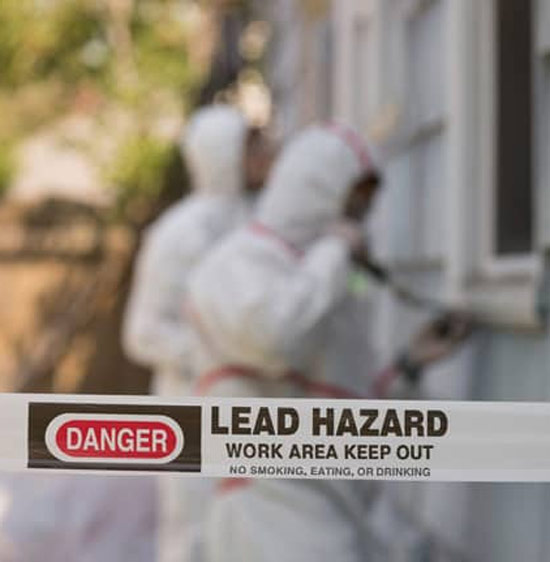Specialist Lead Violation Removal in NYC-- Secure Against Health And Wellness Hazards
Specialist Lead Violation Removal in NYC-- Secure Against Health And Wellness Hazards
Blog Article
Vital Tools and Approaches for Reliable Lead Violation Clean-up
Resolving lead offenses successfully demands a comprehensive approach that mixes the right devices with tactical methods. Simultaneously, the use of specialized cleanup tools, such as HEPA vacuum cleaners and lead-specific cleansing agents, is necessary for extensive pollutant elimination. Reliable containment techniques, consisting of plastic sheeting and unfavorable air stress systems, are essential to stop the spread of dangerous products.
Individual Protective Tools
Personal safety tools (PPE) is a crucial element in the reliable monitoring of lead contamination cleaning. The vital PPE for lead clean-up consists of respirators, safety garments, gloves, and eye protection.
Respirators, particularly those equipped with HEPA filters, are indispensable for filtering system airborne lead fragments, protecting against breathing. Safety clothing, including coveralls and disposable matches, avoids lead dirt from adhering to employees' garments, minimizing the risk of second contamination.
Additionally, rigorous training on the right usage and upkeep of PPE is vital. Employees need to be informed on donning and doffing procedures to stay clear of contamination. Routine examinations and replacements of PPE components are needed to maintain their safety abilities, making certain a safe and certified cleanup operation.
Specialized Cleaning Tools

One more important tool is the wet/dry vacuum, which can successfully clean up both dust and fluid impurities. These vacuums often include HEPA filters to offer an added layer of safety and security. Damp wipes or tack towels are likewise crucial for surface cleaning; they are especially created to record and hold lead bits, lowering the risk of spreading out contamination.
For even more stubborn deposits, specialized lead-removal cleaner are required. These agents are formulated to break down lead bits, making them much easier to get rid of. Scrub brushes with strong bristles can assist in this process, especially on rough surfaces where lead dust tends to adhere much more strongly.
Additionally, encapsulants are made use of to secure lead-contaminated surface areas, protecting against the release of lead dust. These specialized paints and coverings are developed to abide by various substrates, giving a long-lasting solution for lead control.
Effective Containment Methods
Effective containment approaches are essential in minimizing the spread of lead contamination throughout clean-up activities. Executing robust control methods makes sure that lead bits do not migrate to unaffected locations, consequently safeguarding both employees and the setting. One main technique is making use of plastic sheeting to secure off infected zones. Sturdy polyethylene obstacles can be installed from flooring to ceiling to develop a controlled image source workplace, dramatically minimizing the danger of air-borne lead dust dispersal.

To enhance containment, encapsulants can be used to surfaces that are not being gotten rid of or interrupted. These specialized coatings bind lead dust, reducing its availability for resuspension. In addition, all personnel have to use appropriate Individual Safety Devices (PPE), consisting of respirators and non reusable fits, to avoid contamination spread.
Safe Disposal Practices
Ensuring secure disposal practices is a critical element in the administration of lead contamination cleanup. Proper disposal alleviates the threat of Discover More lead re-entering the atmosphere and endangering public wellness (DOH & HPD Lead Violation Removal NYC).
Transporting lead waste calls for adherence to stringent standards. Using certified contaminated materials carriers ensures that the products are handled properly. Documentation, including materializes describing the type and amount of waste, ought to accompany shipments to track the waste from the site of beginning to its final disposal location.
Designated contaminated materials disposal facilities are furnished to take care of lead-contaminated products securely. These facilities commonly employ innovative methods such as stabilization, solidification, or chemical treatment to counteract the lead before disposal. Landfilling in specialized, lined areas that avoid leachate from infecting groundwater is a common method for last disposal.
Normal training for employees involved in lead garbage disposal is critical to keep security requirements and stop accidental exposure. By sticking to these methods, companies can significantly lower the ecological and health influences connected with lead contamination.
Regulatory Conformity Tips

Abiding by governing compliance is paramount in the successful implementation of lead contamination cleaning. Comprehending and complying with government, state, and neighborhood regulations makes certain not only the safety and health of individuals yet additionally the lawful and economic health of the cleanup company. The Epa (EPA) establishes stringent requirements, such as the Lead Restoration, Recommended Reading Fixing, and Paint (RRP) Policy, which mandates correct qualification and training for service providers taking care of lead-based activities.
Conformity begins with a thorough assessment of suitable legislations and regulations. Organizations needs to stay updated on any type of legal adjustments, which can be helped with through regular training sessions and signing up for market updates. Paperwork is another vital conformity element; preserving in-depth records of all activities, consisting of examination records, worker training logs, and disposal manifests, is important.
Moreover, involving with certified lead examiners or run the risk of assessors makes certain that lead threats are correctly identified and minimized. Companies must impose the use of Personal Safety Equipment (PPE) and make sure that security procedures are strictly followed. Lastly, transparent communication with stakeholders, including workers, clients, and regulatory bodies, will foster a culture of compliance and responsibility, eventually adding to a safer and much more effective lead cleaning process.
Conclusion
Effective lead violation cleanup necessitates the combination of specialized tools and tactical approaches to make sure safety and efficiency. Individual safety equipment (PPE) safeguards workers from direct exposure, while secure disposal methods and strict adherence to regulatory compliance are necessary for responsibly handling hazardous waste.
Report this page